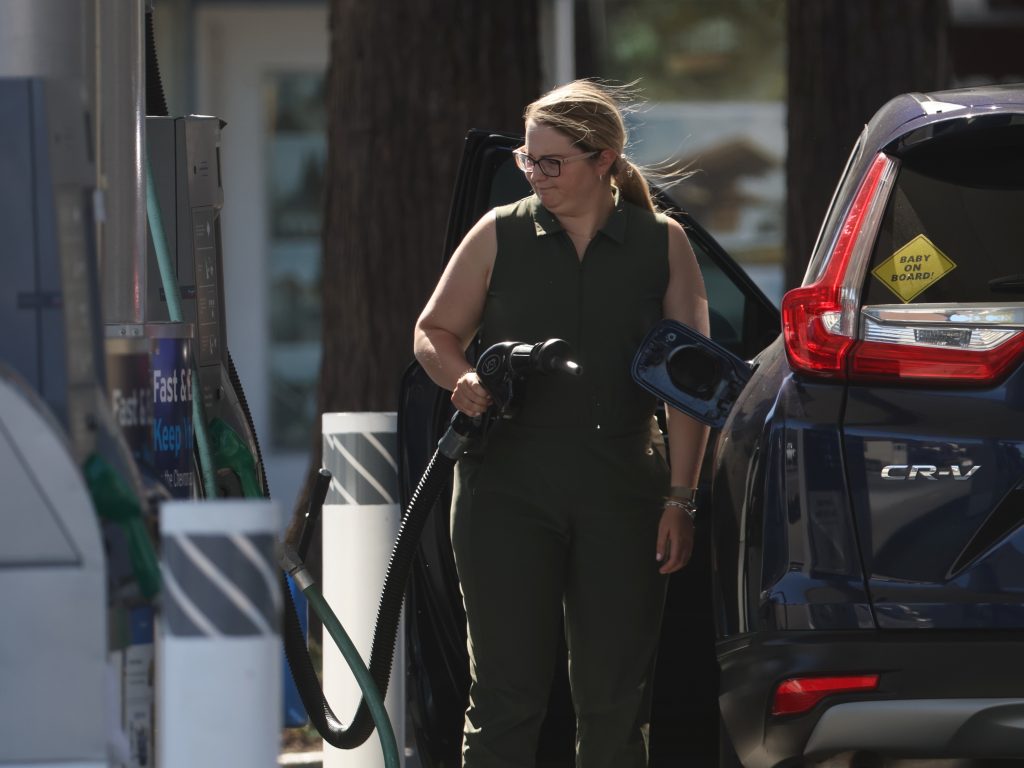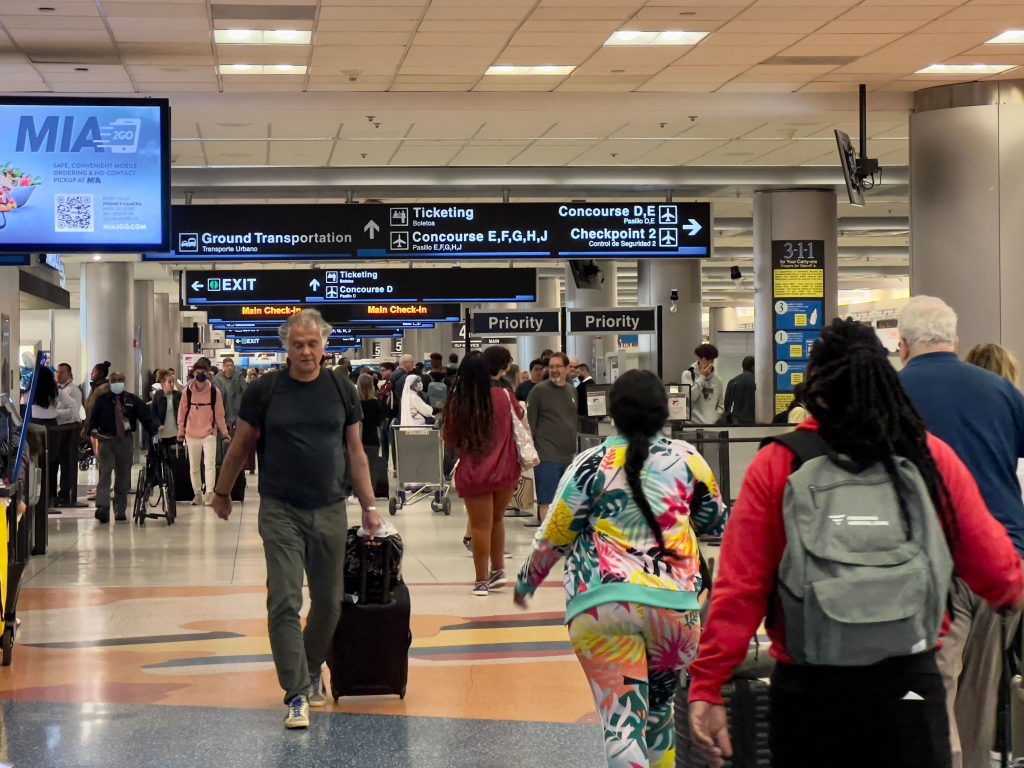News
Inflation soars to an over 40-year high. These are the ways Americans are coping
By: Scott Horsley | NPR
Posted on:
WASHINGTON, D.C. (NPR) — Clay Watkins loves LaCroix brand sparkling water — especially the watermelon flavor.
So the suburban Chicago school teacher was excited when he spotted it on sale at his local grocery store: two packages for $8.
“I went to grab the package and I was like, ‘Wait a second,'” Watkins recalls.
He was surprised to find a package that once held 12 cans of sparkling water had been downsized to 8 — with no change in price — a common practice known as “shrinkflation.”
“I’m not a mathematician,” he says. “I teach science. But I think that’s a 33% price increase.”
(Actually, it’s even worse. The package is 33% smaller, but the remaining cans are 50% more expensive.)
Frustrated, Watkins put the LaCroix water back and fired off a tweet. Later, he bought store-brand sparkling water at Trader Joe’s for 79 cents a liter.
Hey @lacroixwater what gives? Three weeks ago a 12 pack went for $4.99… did you think I wouldn’t notice? #repackage #groceryprices pic.twitter.com/Y2N2Lnxd46
— Clay Watkins (@makingdayscount) June 7, 2022
Many people are facing much more painful decisions as inflation reaches a four-decade high.
The Labor Department said Friday that consumer prices in May were 8.6% higher than a year ago — the largest increase since December of 1981. Prices rose 1% between April and May, led by jumps in the price of gasoline, groceries and rent.
Shoppers who swallowed price increases for much of the pandemic without batting an eye are starting to blink now that gasoline prices have topped $5 a gallon in much of the country and grocery prices continue to climb at a rapid rate.
Cutting back — except for a beloved pet
“The Ukraine war — February, March — was the turning point,” says KK Davey, who tracks shoppers’ behavior at the market research firm IRI.
Davey says since that Russia’s invasion of Ukraine pushed gasoline prices through the roof even middle-income consumers have begun pushing back against price hikes. They’re increasingly turning to discount stores and opting for cheaper generic products.

“There’s a certain crouton that I like. But that is like $1.50 more than the generic Kroger brand, so I’ve switched over,” Lee says. “They’re not bad. But they’re not the quality that I usually like.”
Lee, who lives in West Lafayette, Ind., does not cut corners, though, when it comes to her dog, Potato. The golden doodle still gets name brand pet food.
“She’d still spoiled,” Lee says with a laugh. “She eats the most expensive food out of all of us.”
Still, many are willing to splurge for meals and travel
Davey says it’s not unusual for shoppers to scrimp on some items while splurging on others. They might try to stretch a tube of toothpaste or a bottle of ketchup longer, but when products like toilet paper or baby formula are in short supply, price is no object.
“If you’ve got to have it, you’ve got to have it,” Davey says.
While consumers may be watching their pennies at the gas station and grocery store, they’re still opening their wallets for pricey restaurant meals, airline tickets and hotel rooms. Overall consumer spending has grown faster than inflation every month this year.
When it comes to travel and entertainment, many people are making up for lost time.
“For this summer, there is a mindset of, ‘We’re going on vacation and we’re not putting it off,'” says economist Tim Quinlan of Wells Fargo. “While consumers aren’t happy about prices, they’re sort of willing to pay it to have those experiences for a while.”
The spending can’t last forever, though
But with inflation outpacing income, many people are having to dip into savings to finance that spending, or put it on the credit card. The personal savings rate dipped to a 14-year low in April, while revolving credit grew at an annual rate of nearly 20%.
Quinlan says that can keep spending afloat for a few months, but not indefinitely.
“Come Labor Day, when all these credit card bills come due, everybody will be back on a budget again. And that’s why we expect growth to slow as we head into the end of the year.”

The Federal Reserve is working to accelerate that by raising interest rates and making it more expensive for people to borrow money.
The Fed’s actions may help bring down inflation, but some worry they could trigger a recession.
And Watkins, the teacher who switched to cheaper sparkling water when LaCroix got too expensive, knows not everyone can adjust his spending so easily.
Watkins volunteers at a Chicago-area food pantry where he’s seen a huge spike in traffic over the last six months.
“The people who are really being hurt by gas prices and food prices are the people who don’t have a lot of margin,” he says. “They don’t know where to cut.”
So long as prices keep climbing, more people may have to make difficult choices about what they can live without.
9(MDU1ODUxOTA3MDE2MDQwNjY2NjEyM2Q3ZA000))
Transcript :
RACHEL MARTIN, HOST:
There are new inflation numbers out this morning, and they are not good. Consumer prices in May were up 8.6% from a year ago. That is the sharpest increase since December of 1981. NPR’s Scott Horsley has been talking with consumers who are trying to cope.
SCOTT HORSLEY, BYLINE: For Clay Watkins, sparkling water was the breaking point.
CLAY WATKINS: I really enjoy LaCroix. It’s my carbonated beverage of choice.
HORSLEY: Watkins especially likes the watermelon flavor. So he was excited when he saw it on sale at his local supermarket – two packages for $8.
WATKINS: So I went to grab the package, and I was like, wait a second.
HORSLEY: The package that used to hold 12 cans of sparkling water had been downsized to just eight, but the price was unchanged.
WATKINS: I’m not a mathematician – I teach science – but I think that’s a 33% price increase.
HORSLEY: Watkins, who lives outside Chicago, says his price antenna was already on high alert since he’d just paid $5.50 a gallon for gasoline. So he decided to skip the costly LaCroix water.
WATKINS: I went to Trader Joe’s and got their liter carbonated beverages for 79 cents a liter.
HORSLEY: Many people are facing much more painful decisions as inflation hovers near a 40-year high. For much of the pandemic, retailers and manufacturers have been able to raise prices without suffering any big drop in sales. But ever since Russia’s invasion of Ukraine sent gasoline prices through the roof, even middle-income shoppers have become more sensitive. They’re increasingly turning to discount stores and opting for cheaper store brands.
Joanne Lee buys regular eggs now, not the more expensive free-range kind she prefers. She’s traded down on her salad toppings as well.
JOANNE LEE: There’s, like, a certain crouton I like. But that is, like, $1.50 more than the generic Kroger brand. So I’ve switched over. They’re not bad. But, you know, they’re just not, like, the quality that I usually like.
HORSLEY: But Lee, who lives in West Lafayette, Ind., does not cut corners when it comes to her dog, Potato. The goldendoodle still gets name-brand pet food.
LEE: She’s still spoiled. She eats the most expensive food out of all of us.
HORSLEY: And Lee’s not the only one who’s scrimping in some areas while splurging in others. People may be watching their pennies at the gas station and grocery store, but they’re still opening their wallets for pricey restaurant meals, airline tickets and hotel rooms. Overall, consumer spending has grown faster than inflation every month this year.
Economist Tim Quinlan of Wells Fargo says when it comes to travel and entertainment, people are eager to make up for lost time.
TIM QUINLAN: For this summer, there is a mindset of, we’re going on vacation, and we’re not putting it off. While consumers aren’t happy about prices, they’re sort of willing to pay it to have those experiences for a while.
HORSLEY: But with inflation outpacing income, many people are financing that spending by dipping into savings or putting it on their credit card. Quinlan says that can prop up spending for a time, but not indefinitely.
QUINLAN: Come Labor Day, when all these credit card bills come due, everybody will be back on a budget again. And that’s why we expect growth to slow as we head into the end of the year.
HORSLEY: Ultimately, Quinlan says, it’s likely to take a slowdown in consumer spending to bring prices back under control. The Federal Reserve is working to accelerate that by raising interest rates, though some worry that could trigger a recession.
Clay Watkins, the teacher who switched from a LaCroix to Trader Joe’s brand water, knows not everyone can adjust his spending so easily. Watkins volunteers at a Chicago-area food pantry, where he’s seen a huge spike in traffic over the last six months.
WATKINS: The people who are really being hurt by gas prices and food prices are the people who don’t have a lot of margin. They don’t know where to cut.
HORSLEY: And so long as prices keep climbing, more people may find themselves having to make difficult choices about what they can live without. Scott Horsley, NPR News, Washington.
(SOUNDBITE OF BRAD ENBATA’S “WIND DOWN”) Transcript provided by NPR, Copyright NPR.

